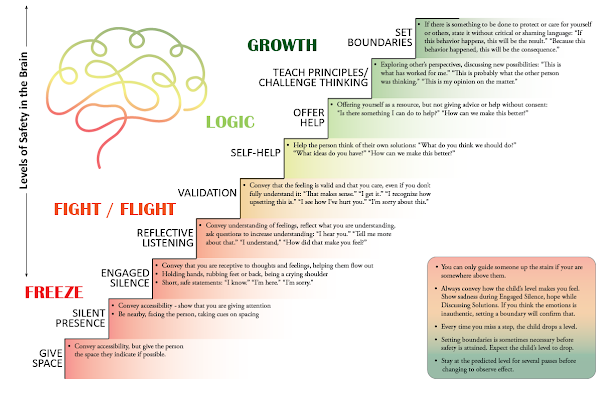For an updated and expanded version of the model, visit this link to the 20-page booklet: https://boonechristianson.blogspot.com/2022/08/steps-booklet.html?m=1
And the 5 minute video version: https://youtu.be/T7l7D1ukw0c
STEPS:Therapeutic Interaction Model
You don’t know what to do when your partner or child has a reaction that seems totally disproportional to the situation. When you try to be rational, the person becomes LESS rational, and a fight breaks out.
The goal in any healthy relationship is to create mutual happiness. We can do this by showing love, THEN, if necessary, helping people change their thinking and behavior, not vice-versa. We do not show love by making them change. We could try to force changes in behavior through coercion, shaming, or fear, but this undermines the ultimate goal, and doesn’t create lasting change anyway. So, our priority is to help someone feel safe, NOT to teach, challenge, critique, fix, or get a certain behavior. If you feel safe, you are much more teachable, much more able to think of solutions, and to make wise and morally sound decisions.
We create safety by adapting our responses to what is happening in the other person’s brain. Here are the general steps you could take to help someone feel safe by meeting them where they are at:
Click the link if the pic here is too blurry:
https://drive.google.com/file/d/10OWFOBAeWTfXFPvIyD5mnRbyL5nqwqvt/view?usp=sharing
*See examples of statements common to each brain state at the bottom of this post.
What I am conveying here is essentially the culmination of my entire therapy education. Please be patient and forgiving with yourself as you recognize things you may want to change. The knowledge helps, but it still takes a lot of work, and even therapists need continual practice. Be flexible, as these principles apply a little differently with each person, and know that the examples here are likely simpler than your actual experience. Please read and reread carefully, and discuss with loved ones:
You will have the best success with others if you can recognize these states within yourself. When did you just want someone to listen while you spouted off non-logical statements or expressed feelings? When did you just want space? When were you ready to receive some honest feedback? What do these states feel like for you?
React to the emotion. If the person is sad, show your sympathy (if you are unable to be sympathetic, you probably aren’t in a place to be helpful). If the person is numb, match that energy (no humor or encouragement yet). Once they start to enter a higher part of the brain, validate their hopefulness.
Body language is the best indicator of someone’s emotional state, not necessarily their words. When someone approaches you wringing their hands with wide eyes asking you how to handle a situation, DO NOT expect a logical answer to help them calm down. Helping them breathe and express their feelings will go further, and likely help them find their own answer.
Every time you mismatch levels too much, you can expect the person to feel less safe and drop a few levels. Everything above or below the level the person is at will be seen as a threat:
-If you Offer Help when the person needs you to Listen, they may shut down, perceiving you as “just trying to fix it.” Parents make the common mistake of giving solutions or trying to get a child to think differently while the child is in an emotional state.
-If you validate or apologize when the person needs space, it will feel “patronizing.”
-If you Give Space when the person is finally ready for you to Listen, they may also shut down–their problem is “not important enough for you.”
Don’t always change levels because you get a negative reaction in the first exchange. It’s ok to allow a few exchanges before you change tack:
Toddler in a crib: “Let me out!” (Fight Brain)
Parent: “I hear you” (Reflective Listening)
Toddler: “LET ME OUT!!!” (Fight Brain)
Parent: “I know you want out.” (Reflective Listening)
Toddler: “I want to keep playing!” (Moving out of Fight into Logic)
Parent: “I understand. Playing is really fun, and going to bed makes you sad.” (Validation)
Toddler: “Yeah” (Logic)
This parent stayed at Reflective Listening after the slight escalation, and the child was ready for Validation.
-Boundaries exist whether or not the person wants to know what they are, but they must be communicated strategically. You may deem it appropriate to remind the person what the boundary is; if so, only remind them once or twice. Remember that the boundary is best received at the top level of the brain, and assertion of the boundary will knock the person down a few levels if they aren’t at the top. If you need to use it, be ready to regain lost ground:
Parent: “It’s time to put the screen away.”
Child: (Ignores, feeling irritated)
Parent: “If you don’t hand it over right now, you’ll lose privileges tomorrow.” (Boundary)
Child (entering Fight Brain due to the boundary): “What the heck! Can’t I just have a few more minutes?”
Parent: (No need to discuss the rule, you know he knows it.) “I’m sorry. I know how annoying this is.” (Validation)
Child: “Ugh. FINE.” (leaving Fight/Flight)
Parent: “That’s a pretty fun game isn’t it?” (Validation)
Child: “Yeah. I almost beat my high score.”
Parent: “Oh yeah? Tell me about that.”
Asserting the boundary twice in this case is unnecessary because the child’s challenge to the boundary is not about a lack of knowledge, it’s about getting more game time (which is a VALID feeling for children!). Repeating the boundary twice might insult the child’s intelligence and could lead to escalation.
-If you think an emotion is fabricated just to get a certain way (what we call instrumental emotion), validating the emotion while setting the boundary will determine what level the child is really at:
Child: (Throws a strong tantrum to get some ice cream.)
Parent: “I see how upset you are (Validate). If you don’t stop kicking the fridge, you won’t get any TV time tonight.” (Boundary)
Child: (Calms down quickly, but still visibly irritated. The boundary revealed that she is on the edge of Fight/Flight, needing validation, not deep in Fight/Flight and needing restraint)
Parent: “You just wanted some more ice cream, huh? It’s my favorite too.”
Child: “Yeah. It’s really yummy.”
Parent: “Would you want to eat some more after lunch or dinner tomorrow?”
You cannot help someone up the steps if you are in Fight/Flight Brain yourself. It is best to Give Space if you are unable to be a safe presence. You certainly cannot set boundaries in this state. If the person you are trying to help is higher up the steps than you, you are in a place to have boundaries placed on you, and perhaps be manipulated. (See “The Brain and The Bucket” to understand how to stay in your logical brain):
Child: Buy me the candy!!! (Ensuing tantrum)
Parent: “Ok ok! Here you go.” (Fight/Flight)
Child calms down instantly (Showing Logical self-control).
This parent is in Flight Brain, too afraid of public embarrassment to hold a boundary with her child, and can thus be manipulated.
The steps below “Give Space” are increasing levels of “Give More Space for More Time.” Hopefully you’re not to the point where the child moves out and doesn’t call you for 10 years, but you might be to the point where you need to attempt 5 conversations, get rejected, and Give Space before your child feels safe enough to even express anger at you. Work through those attempts, and listen to and validate your child’s feelings when they come. If you engage in a fight, you send them back down a few levels.
To sum up:
-Your first goal is to create a safe and loving place for someone, NOT get them to clean their room, do their homework, get a job, or have sex with you. Quit worrying about grades, pay raises, or cleaning the garage while this person only has access to basic survival functions.
-If you try to compel behaviors while someone is anxious, angry, or depressed, you are much more likely to fail. If you do succeed, you will likely make the problem worse in the long run by increasing their resentment. Join them in their feelings and help them through, rather than try to yank them out.
-Do not try to logically challenge or make requests of someone while they are in the emotional brain. These things can only be perceived as threats. If you find that every interaction you have with someone is tense, spend more time listening to them, and less time asking them to do things or challenging them in some way.
-Helping someone feel safe by validating their feelings does NOT mean you need to tolerate all behaviors. Do your best to help them up the steps, but still keep your boundaries. Only remind a person of the boundary if absolutely necessary, and only once or twice (you mostly don’t need to).
-If you think the person is using an emotion to manipulate, still validate to let them know you care, but hold the boundary to let them know the fake emotion won’t get them what they want.
-Get yourself in a good place. You can’t help someone with their emotional dysregulation if you are too distressed yourself.
-Notice that “Shaming” and “Judging” are nowhere on the steps. These behaviors have no place in safe, loving relationships.
Sample statements of what the person might say or do in different parts of the brain:
Give Space (Deep Freeze Brain):
“Go away!”
“I’m not ready to talk about this”
(Turns away in bed or on the couch, ignores you)
Silent Presence (Leaving Freeze)
-Fast breathing, pacing.
-Heavy crying, angry ranting
-Confused, illogical statements
Engaged Silence (Entering Fight/Flight)
-Self-shaming statements “I’m such an idiot!” “I hate myself!”
-Fearful What-ifs, catastrophic statements “I’m gonna get fired” “How can I go on?”
-Angry judgmental complaining “He’s such a dirt bag!” “You’re always putting yourself first!”
Reflective Listening (Fight/Flight)
-Continued statements of less strong emotion: “I just can’t believe I did that” “I’m so scared of what’s gonna happen” “It’s like he doesn’t even care.”
Validation (Leaving Fight/Flight)
-Statements more indicative of feelings, less about what happened: “I’m feeling so embarrassed” “I’m afraid” “I’m really angry”
Self-Help (Entering Logic)
“Maybe I could try this…”
“I know I shouldn’t feel this way”
“It’ll be ok, I just need to think”
Offering Solutions (Logic)
“What do you think I should do?”
“I could use some ideas”
Teaching/Challenging (Growth)
“How did you/others feel when this happened?”
“I want to know your perspective.”
“What have you done in these cases?”

